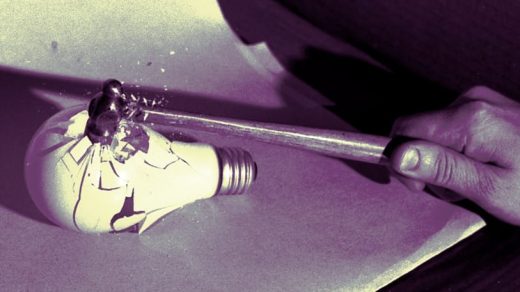Why My Startup Scrapped Its Perfectly Successful Business Model
This spring, Tesla pulled ahead of General Motors to become the most valuable car maker in America. That’s despite GM breaking records in 2016 with 10 million cars sold and earning $12.5 billion in profit. Tesla, meanwhile, delivered 76,230 cars and lost $219.4 million. As dazzling as GM’s numbers are, investors are betting the upstart Tesla has the brighter future.
Is there some dark secret at the heart of GM’s business? A design flaw savvy investors have sniffed out? Not exactly. The simple truth is that incumbent businesses, even those as iconic as GM, are often at a chronic disadvantage. They’re victims of their own success–even while they’re busy succeeding.
Technology has always accelerated change–that part isn’t new–but the pace of that acceleration is quickening. Industry leaders can find themselves industry laggards more suddenly than ever. To sidestep the incumbent trap, companies that are doing just fine sometimes need to ditch their business models and try something totally different. It isn’t easy, but I know from experience that it’s possible.
How My Company Set Its Own Trap
It’s not easy to think of new ways to do business that are different from everything you’ve done before–especially when what you’re doing is working. It’s even harder to follow through and take action. My company, BuildDirect, spent years growing quickly as an online seller of home-building supplies. The company was highly valued and we were doubling our sales every year. We had a great business. Then we changed it fundamentally–on purpose.
BuildDirect ordered goods from suppliers and sold them to customers across North America. We were, for the most part, simply transplanting a brick-and-mortar model online, rather than fully embracing technology to create a different way of doing business. Despite outward appearances, our model was quickly growing obsolete. But the way we could tell was because demand was high, not because it was flagging.
Customers wanted to buy more from us, but we were failing them because much of the time we didn’t have the inventory to make the sale. The data told us what our customers wanted. We’d try to pass that along to our suppliers, but it often got lost in translation. We tried for years to solve this problem but just couldn’t keep up with the growth. So at the end of 2013, I went to our board and told them our only way forward was to change almost everything about how we did business. If we didn’t, we’d eventually stagnate and fail. But if we did, we could create something exponentially more valuable.
Escaping From Success
Our idea was to become a fully open marketplace rather than a “traditional” online retailer. We’d open up everything in our system we’d long held close to our chests–our onboarding of new products, our predictive data about what would sell best, our logistics network for delivery, everything–so our suppliers could understand demand, quickly adjust their inventory accordingly, and give customers what they wanted. In short, we’d get out of the way and put our suppliers in the driver’s seat. What was once proprietary we would give away. Ultimately, this would mean wider selection and better results for customers.
I knew this would be a costly transition and much harder than any business challenge I’d faced before. The technical hurdles were daunting, but not as life-threatening as the loss of faith from key people around us as we went through the process of reinventing the company.
We launched the platform in February 2016 and it took off like a rocket–only to fall victim to its own runaway momentum. Suppliers loved it and added products to our site faster than we could’ve imagined. But parts of the technology that we needed to handle this growth were still in development. As a result, customers couldn’t easily discover the products they needed on our site. Best-sellers were being lost in an avalanche of new product offerings, as we raced to refine our platform to surface what users really wanted and show it to them.
But as hard as it was to pull off, it was the right thing. As lucrative as our initial business model had been, retail was a trap. Better, faster ways to satisfy customers were out there.
Late last year, as the technology caught up to the demand, things began to coalesce. Suppliers can now add thousands of new products without hiccups and make the changes on their business in real time. Customers can find the products that they’re looking for faster than ever before. Most importantly, the reinvention has begun to pay off. We’re a more robust, scalable company that keeps our customers and suppliers happier. At the same time, I know I shouldn’t fall into the trap of thinking it’s the last time we’ll have to make a top-to-bottom transition.
It’s a truism in business that truly great companies make reinvention a habit–so much so that it’s kind of cliché to say so. But it’s a fact. GE has reimagined itself countless times since it began as a lightbulb maker in 1892, and is now one of the most diversified companies on the planet. IBM has a similarly storied history of self-transformation, which includes launching the PC revolution in the 1980s and then selling off much of its PC business in 2005. In a similar vein, much younger companies like Apple and Netflix fearlessly cannibalize successful parts of their businesses–think of Apple’s iPod and Netflix’s mail-order DVD business–to make way for greater innovations.
These kinds of reinventions are never easy, and require enormously costly sacrifices–including at times when they hardly appear necessary on the surface. But as I’ve now learned firsthand, they’re the only way forward.
One CEO explains why the best time to change everything is when it’s working out great.
This spring, Tesla pulled ahead of General Motors to become the most valuable car maker in America. That’s despite GM breaking records in 2016 with 10 million cars sold and earning $ 12.5 billion in profit. Tesla, meanwhile, delivered 76,230 cars and lost $ 219.4 million. As dazzling as GM’s numbers are, investors are betting the upstart Tesla has the brighter future.
Fast Company , Read Full Story
(36)












